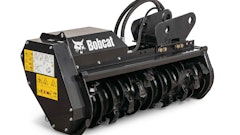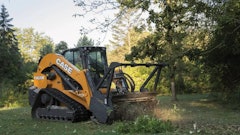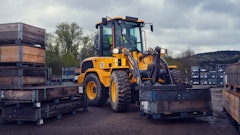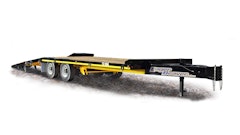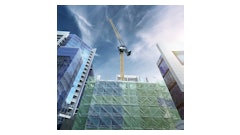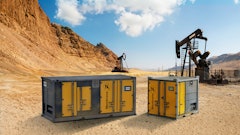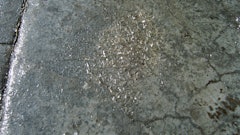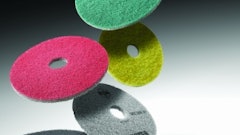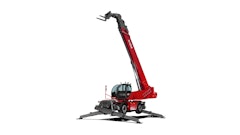
Sightseeing visitors at the Hoover Dam witnessed an unusual sight in April when a Putzmeister 52Z-Meter truck-mounted concrete boom pump was flown over 900 feet above the Colorado River as crews began the final stages of the historical Colorado River Bridge project.
The boom pump, owned by Quinn Concrete Pumping, Inc. (Quinn) of Las Vegas, was carefully placed atop the partially constructed Colorado River Bridge using a cableway system developed specifically for the bridge project. The boom pump was used to place concrete on the arch portion of the bridge deck spanning 1,090 feet. Once completed, the new bridge will connect Arizona and Nevada over the Black Canyon, approximately 1,500 feet south of the Hoover Dam.
Begun in early 2005, the Colorado River Bridge is a joint venture of Obayashi Corporation and PSM Construction USA, Inc. (Obayashi/PSM JV). The bridge is being built to alleviate traffic congestion on U.S. Highway 93, which currently crosses the Hoover Dam to pass over the Colorado River. It has been billed as the most technically challenging bridge to ever be built in North America. As such, each phase of construction presented unique challenges - with this final stage proving no different.
By April 2010, most of the bridge was finished: the bridge approaches to the arch in Nevada and Arizona were complete, the concrete twin arches had been joined together, the precast columns on the arch had been set, and the steel girders were erected. It was time to start work on the 11 separate deck pours; each pour would be 88 feet wide and approximately 120 feet long.
Obayashi/PSM JV selected Quinn as the concrete pump sub-contractor. Throughout the Colorado River Bridge project, Quinn supplied both pump operators and their own concrete pumping and placing equipment. Earlier in the project, the company had been on site to place concrete for the footings and arch foundation.
Because of the large area each deck pour covered, which had to be poured symmetrically on both sides, the decision was made to use Quinn's 52Z-Meter semi-trailer-mounted concrete boom pump. They had been using their own Putzmeister MX 32/36Z placing boom previously on the arches and for shorter-distance pours but now needed equipment with more reach. With the 52Z-Meter's 170-foot vertical and 158-foot horizontal reach, handling the 120-foot deck pours would be no problem. Instead the challenges lay elsewhere: flying the boom pump up to the deck, pumping in tight quarters, balancing deck pours on the bridge, and pumping concrete to the 52Z.
Transporting the boom pump to location on the deck was handled with precision via the cableway system that had been used successfully throughout the project to deliver materials and equipment. However, before the boom pump could be flown to the deck, the crew had to address space requirements on the bridge.
To save on flyweight and reduce the unit's footprint, the boom pump was detached from the tractor.
The boom pump's versatile semi-trailer design, with a separate diesel engine, allowed it to be easily detached, flown to the bridge deck, and then attached to a specially-designed concrete counterweight that simulated the weight of the tractor and took up less space.
"The 52Z was basically being used like a placing boom," says Alan Woods, Putzmeister field service technician.
Because the arch of the bridge had to be loaded symmetrically, the boom pump and counterweight were set up in the middle of the bridge. The geometry of the arch itself would change and would be more difficult to control if the bridge was not loaded symmetrically.
To ensure everything stayed balanced, one deck section was poured on one side of the boom pump, then the boom pump was lifted and turned and another deck section was poured on that side. The boom pump was then lifted and turned again to continue the pour in this manner, going back and forth throughout all 11 pours.
The purpose for the boom pump being lifted and turned for each side's pours was because the pipeline leading from the trailer pump to the hopper of the 52Z-Meter would be in the way of placing the concrete if the boom pump was not lifted and turned each time.
The trailer pump was also moved back and forth for each side's pours and connected to pipeline.
Although Obayashi/PSM JV had used a concrete ready mix supplier earlier in the project, in late 2007 they began operating their own concrete batch plant. For the deck pours, they used a harsh 4,500-psi mix with fibers in it to help control cracking on the deck. Because this was such a tough dry mix, using the right trailer pump was crucial.
Another challenge was how far horizontally the concrete would need to be pumped. The crew decided to use Quinn's BSA 14000 to pump a distance that started at 700 feet and reached a maximum of 950 feet through pipeline, plus another 170 feet through the 52Z-Meter.
With the highest pressures and outputs available, the high-performance trailer pump easily maintained a continuous flow of the harsh mix and facilitated the long-distance concrete pumping.
"First we pumped through the pipeline and into the hopper of the 52Z-Meter, which then pumped the rest of the way," explains Wes Pollnow, construction manager for Obayashi/PSM JV. "The trailer pump really provided the power we needed to push the concrete up and out to its final destination. It averaged 75 cubic yards per hour and at one point reached 100 cubic yards per hour. The trailer pump provided a smooth, controllable output of concrete because of its free flow hydraulic technology. Its fully adjustable volume control allows for very slow pumping while retaining full concrete pressure."
The trailer pump pumped the concrete at 4,060 psi and the 52Z at 2,175 psi.





